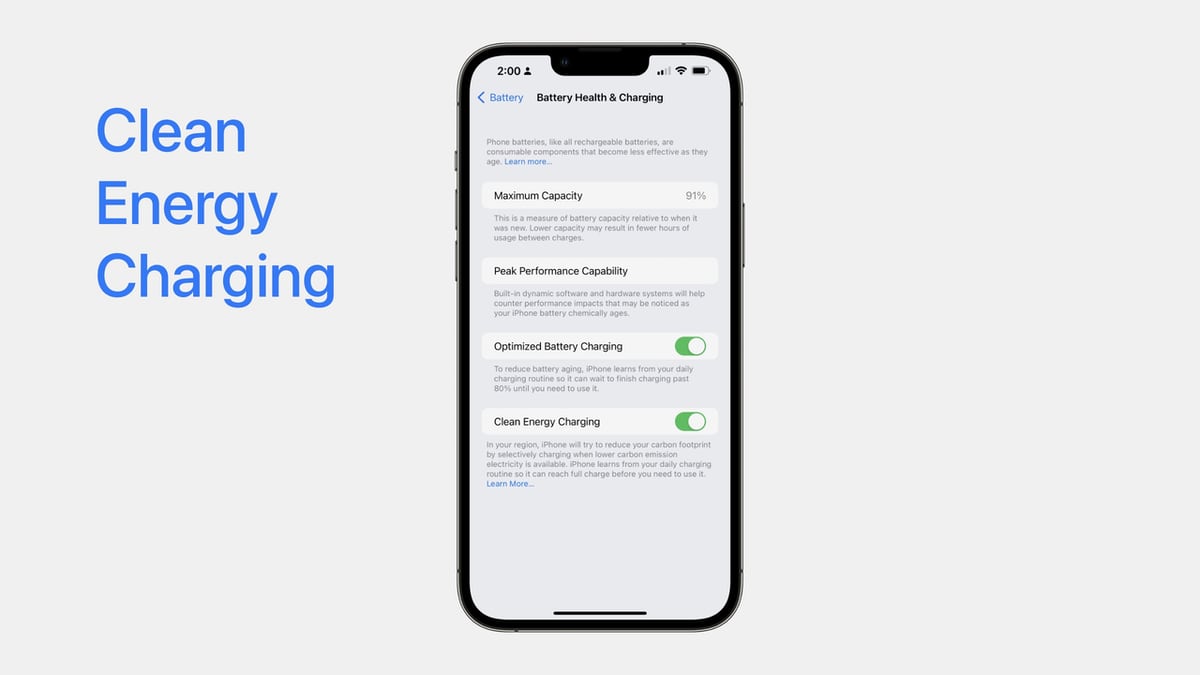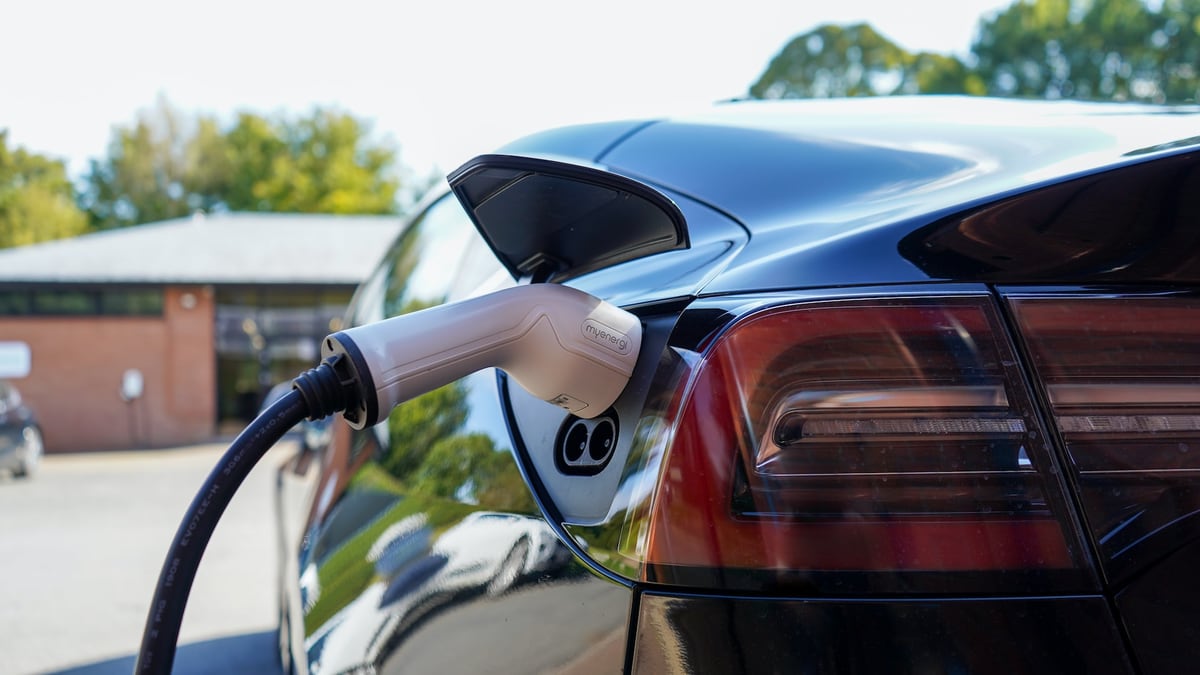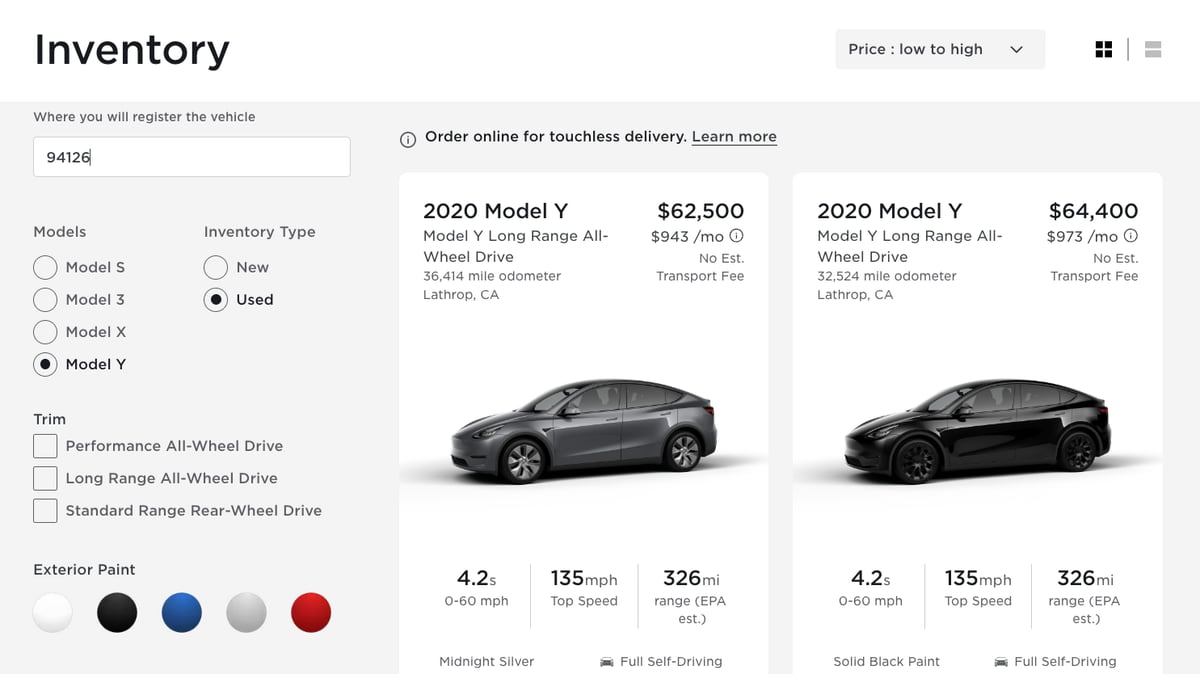By Kevin Armstrong

A familiar alternative has distracted the mega-company spotlight that is usually shining on Tesla. Apple launched the iPhone 14, and with it comes a new operating system — iOS 16. Apple’s newsroom published a lengthy article detailing all the new features of the latest iOS. Of all the new features, there was one that stood out. Deep in the footnotes is a piece of information that likely has caught the attention of Tesla.
In an iOS update due out this fall (iOS 16.1), Apple will debut a new feature called: Clean Energy Charging.
In an iOS update due out this fall (iOS 16.1), Apple will debut a new feature called: Clean Energy Charging. But, unfortunately, they don’t give us much information. The footnote reads, “Clean Energy Charging aims to decrease the carbon footprint of the iPhone by optimizing charging times for when the grid is using cleaner energy sources.”
As a reminder, one of Tesla’s many missions: Electric Vehicles, make badass, zero-emissions vehicles that can charge with clean energy. It’s the end of that statement that falls in line with what Apple has figured out. Clean energy comes from zero-emission, renewable sources.
Apple may use information similar to Watttime. The founders of Watttime asked the simple question, “How clean is the electricity I’m using right now?” The non-profit figured it out. All users have to do is enter a zip code, and they will find an intensity scale from 1-100. The scale measures the grid emissions. The lower the number, the cleaner the energy.
This kind of feature would require a lot of information gathering from users. For example, let’s say you plug in your phone when you go to bed at 11 p.m. and unplug it when you wake up at 7:00 a.m. With this update, the phone would start charging when the grid is cleaner, that may be at 3 a.m. Tesla would have the same information on users. The company knows that the commuter crowd may plug in when they get home, but the car doesn’t need to be recharged until 8:00 the following day.
Tesla’s impact reports detail how the company stores energy during times of high renewable generation, such as wind, solar and others. As a result, the company is proud to say it has created more energy than its products have consumed. The next step would be to have Tesla products consume only the cleanest energy whenever possible.
By Lennon Cihak

It’s rumored that Apple CarPlay will soon support paying for gas directly from the CarPlay interface. According to MacRumors, the feature was first mentioned in a developer session at WWDC earlier this month.
“Entering payment credentials in the iPhone app ahead of time will allow users to activate a pump and quickly purchase fuel directly from the CarPlay UI,” writes MacRumors.
Gas firm HF Sinclair will be jumping on board with this new technology.
“We are excited by the idea that consumers could navigate to a Sinclair station and purchase fuel from their vehicle navigation screen,” Jack Barger, HF Sinclair’s senior vice president of marketing, told Reuters.
With numerous EV chargers popping up such as ChargePoint and Electrify America, Tesla should consider adding a way to pay for third-party chargers directly from the vehicle.
Tesla owners are already afforded the luxury of easy payment at Superchargers because their payment information is stored in their Tesla account.
This functionality could save consumers a lot of time and hassle. In its current form, the only way to use a specific charging station, say, ChargePoint, is to download their application, create an account, enter your payment information, and begin.
But this approach isn’t entirely ideal because if you’re in an area that doesn’t have cellular reception/internet connection then you won’t be able to create an account to charge your vehicle.
If Tesla worked with other charging companies, like ChargePoint, Volta, and Electrify America, there could be a seamless integration for charging infrastructure.
Ideally, this integration would have to be easy to use. For example, I should be able to search in my vehicle for a non-Tesla charging location, add it as a destination so Tesla preconditions the battery before arriving, and upon arrival, it informs you which stall you’re going to charge at. If there’s a wait, it will notify you of how long you’ll be waiting and estimate what this charging stop will cost.
By Kevin Armstrong

Tesla’s used car division is transforming how people buy vehicles, and they are not resorting to “wacky waving inflatable arm flailing tube men” to do so. Tesla’s Director of Sales and Delivery Operations, Jimmy Douglas, told Electrek that he doesn’t need the attention-grabbing inflatables to beat the online used car giants.
Tesla seemingly stumbled into a brilliant plan to sell its used cars. In 2019, the electric vehicle trailblazer announced that it would not allow people who leased their Model 3s to sell them after; instead, the vehicle must be returned to the dealership. The original plan was to retrofit these previously loved cars to become the RoboTaxi. The RoboTaxi program, a fully autonomous vehicle that would take over the ridesharing sector, is still under development, so now Tesla has thousands of cars coming back to the lot.
The timing could not be more ideal. The demand for EVs has never been higher. However, some prospective buyers get sticker shock when shopping for electric vehicles, including the biggest name in the sector. A simple solution is to buy used. Used vehicle sales topped 40 million in the United States alone in 2021, compared to 15 million new vehicles.
Nevertheless, there is still the longstanding stereotype of the sleazy, used car salesperson pushing a shiny lemon at unsuspecting shoppers. That is certainly not the case with Tesla. Instead, the used car sales run similarly to the new car buying experience.
Douglas said to Electrek, “Most people don’t realize that Tesla runs its own vertically-integrated, nationwide online used car retailer. It’s as big as some publicly traded used car retailers you’ve definitely heard of, despite no Super Bowl commercials.” It can only be assumed he is referring to Carvana, which launched its Over Sharing Mom commercial during the 2022 Super Bowl. The used car company is valued at $4.69 billion.
Tesla does not have a line item showing how much its used car division is worth. That section of the company falls under Services and Other; on the most recent filing with the SEC, that number is $1.4 billion.
While it is not Carvana’s value, it is still a big chunk of change, especially because Tesla has recently stopped lessees from selling any of its products at the end of the term. That means a never-ending supply of used cars will be returned to the dealership.
In addition, the company is preparing for growth in this division. A recently posted job at Tesla reads: “Would you like to be part of a team transforming the way people buy a car?” Douglas is hiring an associate manager of used car quality. The posting continues, “As a leader in Tesla’s Used Car business, you are responsible for the development of the refurbishment process and managing daily refurbishment operations.”
Perhaps the used car division will get more respect in the future at Tesla and not be lumped into the ‘other’ category. That category has grown by 50 percent since last year. At this pace, used cars deserve a line of their own.






